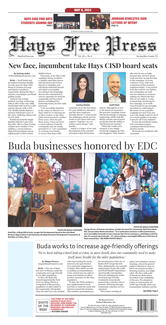By Moses Leos III
Yellow was the predominant color on Saturday night in front of the second largest crowd in Bobcat Stadium history.
A myriad of penalties, along with a determined Navy Midshipmen effort, hindered the Texas State Bobcats in a 35-21 defeat.
“Penalties hurt us. We shot ourselves in the foot offensively,” Texas State head coach Dennis Franchione said. “You can’t play these guys and miss (scoring) opportunities. It’s hard to do that.”
Texas State’s penalty problems began on their very first drive. Already trailing 7-0, the Bobcats marched 69 yards all the way to the Midshipmen six-yard line.
But three 15-yard penalties, the last a delay of game on Franchione, pushed the Bobcats to the Navy 42. The drive ended with a 32-yard field goal attempt from Jason Dann that careened off the right upright.
It became the theme for the Bobcats, who saw several drives falter due to penalties. The Bobcats amassed 124 yards on 11 penalties in the game.
The struggles were magnified by Navy’s defense, which kept the Bobcats scoreless for roughly 29 minutes. Franchione said Navy made the Bobcats “earn everything” on offense.
On the opposite end, Navy’s prolific triple-option attack hit the ground running. Guided by backup quarterback Tago Smith, the Midshipmen unleased a 28-point salvo on their first four drives of the first half.
Smith finished with 213 total yards, 96 on the ground and four total touchdowns.
Overall, Franchione said the Bobcats defended Navy’s rush game well; they limited the Midshipmen to 352 yards. Navy averaged 428 rush yards in their first two games. However, the Bobcats were often misaligned by Navy’s intricate option attack, causing issues.
“That’s how they have success. If you miss some assignments, you aren’t fitted the right way and they make you pay,” Franchione said.
Navy opened up a 28-0 lead before the Bobcats fought back before halftime. Texas State drove 75 yards on 17 plays, with Jones plunging one yard into the end zone to cut the Navy lead to 28-7.
Despite their problems, Texas State’s offense managed to maintain equilibrium. The Bobcats gained 469 total yards, 255 at the half.
Bobcat quarterback Tyler Jones said the team could have capitalized on several scoring drives were it not for the penalties. Running back Robert Lowe said the run game was working, but the team “shot ourselves in the foot over and over.”
“This was something in practice we knew we couldn’t do against a team like Navy,” Lowe said. “We had to maximize our opportunities when we have the ball. We didn’t do that.”
Jones went 24 of 36 for 231 yards, while Lowe rushed for 92 yards.
Texas State’s defense rallied in the third quarter. The unit came through with two key defensive stops, which included a goal line stand and an interception from defensive back Germod Williams.
The Bobcat offense still couldn’t generate any offensive momentum. That changed in the fourth, as the Bobcats concocted a 9 play, 29 yard drive, capped off by Lowe, who leapt over the pile on third and goal to cut Navy’s lead to 28-14.
But that was as close as the Bobcats could get. Less than a minute later, Navy deflated Texas State hopes with a 67-yard pass play from Smith to Jamir Tillman, putting the game out of reach.
Franchione said the plan was to force Navy to beat Texas State with the pass. However, he didn’t anticipate Smith throwing as well as he did. Smith finished with 117 passing yards.
“That’s what happens when you play an offense like that,” Franchione said. “You got the press, the issues in the run areas and you get vulnerable there.”
With Illinois on the horizon, Jones focused on improving — both on limiting penalties and strengthening gameplay.
“The tapes will show, the videos will show things we got to work on, things we have to get better on,” Jones said.




